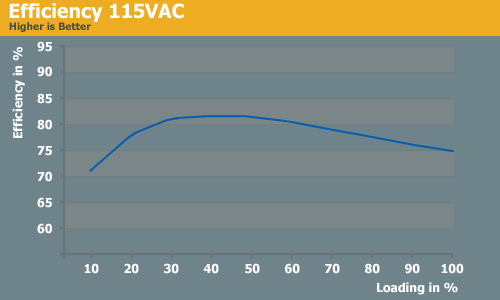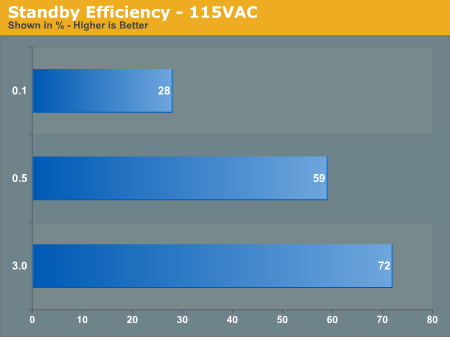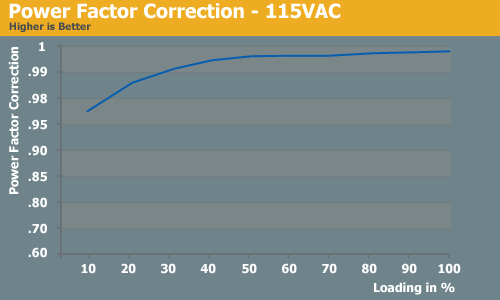The Single 12V Rail SilverStone Olympia OP650
by Christoph Katzer on July 13, 2007 12:00 PM EST- Posted in
- Cases/Cooling/PSUs
115VAC Efficiency, Power loss and PFC
Efficiency is one of the most important factors nowadays in power supplies. PSU marketing and advertising are completely dependent on efficiency in most cases. At 115VAC we have measured a little more than 80% efficiency from 25% to 60% load. That is surely an impressive number with 115VAC. It is nice to see that Silverstone is able to maintain this high efficiency through the full spectrum of loads and not only for a few specific loads like some other power supplies. After it reached its zenith it steadily declines in efficiency, but not too rapidly.

Due to a high efficiency the power loss was in quite good shape as well. The thinner this graph is the less power loss we have measured. The loss of power is always higher towards the highest load which results in the figure below.

Even when you turn your PC off it is, unfortunately, still using energy if you don't hit the hard power switch on the backside. This is the standby function which lets the PC start with soft power features like wake on LAN. Since the PC is on standby it is always using energy from the grid. We have included this test to check power supply's standby function and their energy usage while the PC is off. With 115VAC the OP650 is using 1.19 watts of energy while doing "nothing" which is not a very high result. If you leave the PC off for a long period of time, you should still always hit the switch or unplug the cable.
To test the standby-efficiency we are using the loads of 0.1, 0.5 and 3.0 Ampere on the 5VSB rail while the power supply is not running. The result is the efficiency of each load shown below. The results are quite average but not low. A standby-efficiency of 72% with 3 Ampere of load is very good.

Power factor correction works fine and delivers the usual high results. It always performs better at 115VAC as opposed to 230VAC.

Efficiency is one of the most important factors nowadays in power supplies. PSU marketing and advertising are completely dependent on efficiency in most cases. At 115VAC we have measured a little more than 80% efficiency from 25% to 60% load. That is surely an impressive number with 115VAC. It is nice to see that Silverstone is able to maintain this high efficiency through the full spectrum of loads and not only for a few specific loads like some other power supplies. After it reached its zenith it steadily declines in efficiency, but not too rapidly.

Due to a high efficiency the power loss was in quite good shape as well. The thinner this graph is the less power loss we have measured. The loss of power is always higher towards the highest load which results in the figure below.

Even when you turn your PC off it is, unfortunately, still using energy if you don't hit the hard power switch on the backside. This is the standby function which lets the PC start with soft power features like wake on LAN. Since the PC is on standby it is always using energy from the grid. We have included this test to check power supply's standby function and their energy usage while the PC is off. With 115VAC the OP650 is using 1.19 watts of energy while doing "nothing" which is not a very high result. If you leave the PC off for a long period of time, you should still always hit the switch or unplug the cable.
To test the standby-efficiency we are using the loads of 0.1, 0.5 and 3.0 Ampere on the 5VSB rail while the power supply is not running. The result is the efficiency of each load shown below. The results are quite average but not low. A standby-efficiency of 72% with 3 Ampere of load is very good.

Power factor correction works fine and delivers the usual high results. It always performs better at 115VAC as opposed to 230VAC.











46 Comments
View All Comments
meeshu - Thursday, July 19, 2007 - link
I would have liked to have seen results of ripple tests, regardless of whether they are within spec or not.Piyono - Sunday, July 15, 2007 - link
As your power supply testing methodology continues to evolve do you see yourself retesting previously reviewed units, if necessary? My concern is that all test results should be directly comparable between all reviewed units.Thanks,
Piyono
Christoph Katzer - Monday, July 16, 2007 - link
If it's possible (a matter of time) we will do it.Piyono - Sunday, July 15, 2007 - link
Very good first PS review.As an audio guy I feel it's necessary to point out that the *frequency* of the sound generated by a fan has a lot to do with how loud / annoying we might perceive it to be. The human ear, as we know, is not linear and is more sensitive at some frequencies than at others (for those unfamiliar with the concept, Google "Fletcher Munson equal loudness curve" or try the [url=http://en.wikipedia.org/wiki/Fletcher-Munson_curve...">http://en.wikipedia.org/wiki/Fletcher-Munson_curve...]Wikipedia entry[/url]).
For example, given two fans outputting 40dBSPL, one generating a tone centered at 1KHz will be far more annoying than one with a fundamental of 600Hz, simply because the ear is particularly sensitive around 1KHz, and less so at 600Hz.
Given the quality of your audio test equipment (great choice on the MG mic & pre, BTW) you can easily create an accurate frequency plot of the PS's audio output. Perhaps you could include these frequency plots in future reviews, along with sample recordings of the actual fan noise.
Just a thought.
I've been waiting a long time for a review site to pick up some chroma gear and put out consistent PS reviews. Kudos!
Piyono
mindless1 - Wednesday, July 18, 2007 - link
It can be problematic picking a high wattage PSU based on fan noise frequency. It is actually better to have a higher fan frequency for PSU lifespan, because that higher frequency is typically caused by use of ball bearings instead of sleeve bearing, which is much more reliable in a horizontally mounted PSU fan.If the noise is important I suggest you use a system that doesn't consume much power and has the older rearward facing fan (being a quality sleeve bearing, brand like Papst or Panaflo).
Christoph Katzer - Sunday, July 15, 2007 - link
Thanks, actually we are still working on the audio-equipment. When it's ready we will have quite some data to show.Piyono - Sunday, July 15, 2007 - link
Hey, that's good to know.I'm eager to see how this develops!
Piyono
xsilver - Saturday, July 14, 2007 - link
do silverstone manufacture this psu themselves or do they subcontract it to an OEM company like etasis?im most intrigued because they make the ZF series of psu's which have a dual PCB design
http://www.xbitlabs.com/articles/other/display/atx...">http://www.xbitlabs.com/articles/other/display/atx...
this review tells of how this is one of the very few psu's to actually have true independent voltage regulation; not sure how that has any real world effect but it at least looks like one of the most jam packed psu's i've ever seen.
Operandi - Saturday, July 14, 2007 - link
A good PSU review the proper way isn't an easy thing but it looks like you guys have an excellent handle on it, great work.maluckey - Saturday, July 14, 2007 - link
I noticed that the secondary heatsink temperature reached 90 degrees during testing. I've never been a fan of Teapo capacitors, and I suspect (though not stated in the article) that the caps on this PSU are NOT 105 C. caps. This means that given time, the degradation can be significant and the MTBF will rise accordingly. Can anyone justify 170 doolars a new PSU every couple of years? Especially when 35 dollars in better caps would change all that. It would basically future-proof your purchase, though the manufacturer would have to raise the price accordingly as they are not in the business of charity.I forsee this happening as soon as the majority of home users expect more from a PSU than a shiny case or blinky lights and a wildly opptimistic output rating.